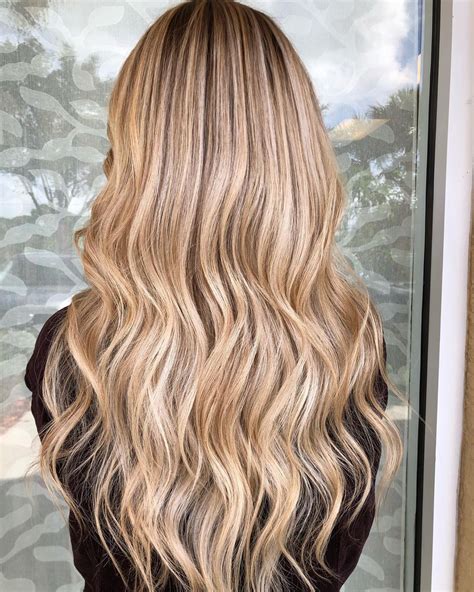Introduction

Butter blonde hair, a captivating shade that radiates warmth and elegance, has stolen the hearts of countless hair enthusiasts. Its soft, golden hues evoke the richness of butter, creating a luxurious and flattering look. Achieving and maintaining this coveted color requires a careful approach, considering factors such as base shade, hair condition, and desired intensity. In this comprehensive guide, we delve into the intricacies of butter blonde hair, unveiling 33 indispensable tips to help you embrace this alluring look with confidence.
Understanding Butter Blonde Hair
Key Characteristics:
- Warm, golden undertones
- Can range in intensity from soft and subtle to rich and vibrant
- Complements a wide variety of skin tones, particularly warm and neutral undertones
- Requires regular maintenance to preserve its vibrancy
Types of Butter Blonde:
- Buttery Blonde: A subtle, natural-looking shade with warm, golden highlights
- Creamy Blonde: A richer and creamier shade with a blend of warm and cool tones
- Golden Blonde: A vibrant and intense shade with deep golden undertones
- Honey Blonde: A warm and sweet shade with a slight reddish tinge
- Caramel Blonde: A rich and decadent shade with a blend of golden and brown tones
Benefits of Butter Blonde Hair:
- Enhances warmth in skin tone
- Brightens and illuminates the face
- Creates a youthful and radiant appearance
- Versatile and flattering for various hair textures and lengths
- Adds depth and dimension to hair
Prerequisites for Butter Blonde Hair:
- Healthy hair: Butter blonde requires a healthy hair base for optimal results. Damaged or over-processed hair may struggle to hold the color.
- Natural hair color: Achieving butter blonde is easier on natural hair than on previously colored or bleached hair.
- Realistic expectations: The final result may vary depending on your natural hair color and the condition of your hair.
Step-by-Step Guide to Achieving Butter Blonde Hair
1. Professional consultation: Consult with a professional hair stylist to discuss your desired shade and evaluate the condition of your hair.
2. Hair Preparation: Nourish your hair with deep conditioning treatments and protein masks to strengthen and protect it before coloring.
3. Bleach application: Apply bleach to the hair, leaving it on for the recommended time to lighten the base color.
4. Toner application: Use a toner to correct any unwanted brassiness or orange tones and achieve the desired butter blonde shade.
5. Post-treatment care: Use color-safe shampoos and conditioners to preserve the vibrancy of the color.
6. Regular touch-ups: To maintain the butter blonde hue, schedule regular touch-ups to refresh the color and cover any new growth.
Tips for Maintaining Butter Blonde Hair
1. Avoid over-washing: Excessive washing can strip away the hair’s natural oils, leading to dryness and color fading.
2. Use sulfate-free shampoos: Sulfates are harsh detergents that can damage the hair and cause color loss.
3. Deep condition regularly: Deep conditioning treatments help restore moisture and prevent breakage.
4. Protect from heat: Heat styling can damage the hair and dull the color. Use heat protectant sprays and limit the use of hot tools.
5. Avoid chlorine: Chlorine in swimming pools can react with the hair color, causing discoloration.
6. Use hair masks: Hair masks are an excellent way to nourish and revitalize the hair.
7. Get regular trims: Split ends can make the hair appear dull and unkempt. Regular trims remove split ends and promote healthy hair growth.
Celebrity Inspiration:
Numerous celebrities have embraced the allure of butter blonde hair, including:
- Blake Lively
- Jennifer Lopez
- Gisele Bündchen
- Beyoncé
- Reese Witherspoon
Frequently Asked Questions (FAQs):
1. What is the difference between butter blonde and golden blonde?
Butter blonde has warmer undertones and is typically less intense than golden blonde.
2. Can I achieve butter blonde hair at home?
Achieving butter blonde hair at home is possible but recommended for experienced colorists. Professional stylists have the expertise and tools to ensure optimal results.
3. What are the potential risks of bleaching hair to achieve butter blonde?
Bleaching can damage the hair if not done correctly. It is important to use high-quality bleach and follow the recommended processing time.
4. How often should I touch up my butter blonde hair?
Touch-up frequency depends on factors such as hair growth rate and desired color intensity. Generally, touch-ups are recommended every 6-8 weeks.
Conclusion
Butter blonde hair is a captivating and radiant shade that embodies warmth, elegance, and glamour. By following these 33 essential tips, you can achieve and maintain this alluring look with confidence. Remember to consult with a professional hair stylist, prioritize hair health, and embrace the transformative power of butter blonde hair. Its ability to enhance your skin tone, brighten your face, and add depth and dimension to your hair makes it a truly
